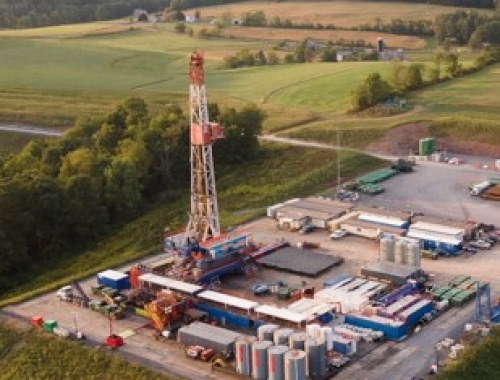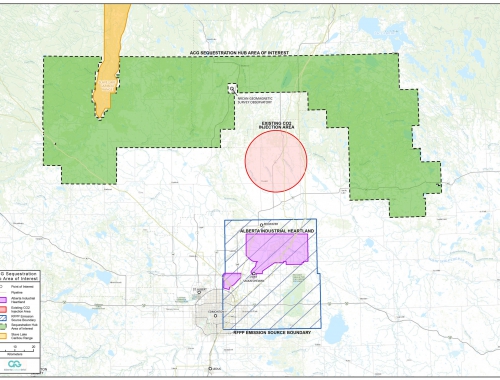Alberta Carbon Grid progresses vision for CCS hub
SUMMARY
Industrial Heartland project would be first of several CCS hubs envisioned by TC Energy and Pembina Pipeline. [Image: Alberta Carbon Grid]
By Dale LunanPOSTED IN:
Canadian midstream and energy infrastructure leaders TC Energy and Pembina Pipeline (Pembina) are deeply immersed in the evaluation of the carbon sequestration potential of their Alberta Carbon Grid (ACG) project, which is targeting to sequester 10mn tonnes/year of CO2 from Alberta’s industrial emitters.
ACG’s proposal for the Alberta Industrial Heartland project was submitted as part of Alberta’s request for full project proposals issued in late 2021 and accepted by the province in March 2022. Following this milestone, TC Energy and Pembina started evaluation work, executing an Evaluation Agreement in October 2022.
“If the evaluation demonstrates that the proposed projects can provide permanent storage, companies will be able to apply for the right to inject captured carbon dioxide,” the government says on a website dedicated to the hub development process. “Only projects that meet Alberta’s rigorous safety and environmental standards will ultimately be approved by the AER (Alberta Energy Regulator).”
The ACG Alberta Industrial Heartland project would provide for the sequestration of up to 10mn tonnes/yr of CO2 gathered from emitters in Alberta’s Industrial Heartland area, a region of heavy industrial development on the northeastern outskirts of Edmonton. Pembina will be the operator of the hub when it goes into service.
A final investment decision (FID) regarding the ACG Industrial Heartland project is anticipated in 2024/25 and ACG expects increased specificity and greater details regarding capital expenditures as they progress closer to FID.
Beyond the Industrial Heartland CCS development, ACG is exploring options to potentially create a number of hubs throughout the province that would be designed to collect and store CO2 from customers across multiple industries.
“We’re currently focused on our ACG Industrial Heartland project to service emitters in that area,” Lindsay Mackay, TC Energy’s vice-president, non-regulated commercial and business development, tells Gas Pathways. “We are committed to advancing the important work required to meet federal emissions targets and the experience our team has gained working on the ACG Industrial Heartland project sets the foundation for future hubs we may advance.”
As part of the provincial development process for the ACG Industrial Heartland project, TC Energy and Pembina are evaluating the suitability of its sequestration area of interest (AOI), which spans some 900,000 hectares north of Edmonton, making it one of the largest areas available for development under the hub process.
“We’re pleased with the progress made on our evaluation programme to date, which is critical as we look to provide confidence to potential customers, indigenous communities, stakeholders, rightsholders and the government of Alberta in the suitability of ACG’s area of interest for safely storing carbon from industrial emitters,” Mackay says. “This important work signals ACG’s commitment to moving this project forward and helping meet Canada’s emissions targets.”
ACG’s AOI is no stranger to carbon sequestration. Located in the Basal Cambrian Sandstone (BCS) structure, it is the same geological home to some 7mn tonnes of CO2 captured and stored by Shell Canada’s pioneering Quest CCS project. The BCS – which extends from northwest Alberta to southeast Saskatchewan – is an ideal candidate for carbon sequestration, with sufficient porosity and permeability to support CO2 injections and thickness and volume to provide high storage capacity. ACG will inject CO2 into the same deep saline aquifer used by Shell at its Quest project, which ultimately plans to sequester some 27mn tonnes of CO2 over the next 20 years, using only about 10% of the available space in the aquifer, which spans about 3,600 km2.
TC Energy and Pembina began the evaluation work early this year and expect to be finished the process in 2024. Completed work includes a field 2D seismic programme, data from which will be combined with existing seismic data to bring a better understanding of the geological formations within the AOI, says Fabrizio Chiacchia, vice president, new ventures at Pembina.
“This data will be integrated into subsurface geophysical models and help guide the location of an evaluation well to be drilled later in 2023,” he says. “We’re excited to continue this exploratory work through the remainder of 2023 while continuing to collaborate with indigenous communities, key stakeholders, and governments.”
After the evaluation well has been drilled, it will be temporarily plugged while data and samples collected during drilling are analysed and evaluated to develop a longer-term development plan, Chiacchia says.
“Once the development plan is complete, the evaluation well will be completed as a monitoring or observation well,” he says.
For more information on the Alberta Carbon Grid project, visit albertacarbongrid.ca
This article is brought to you by the International Gas Research Conference (IGRC2024), taking place from May 13-16, 2024 in Banff, Alberta, Canada. Gas innovations from a global perspective will underpin IGRC2024. Call for Papers is now open! Join in the dialogue that will shape the future of natural gas and gaseous energy industry. Submit your paper abstract and learn more about the topics today at https://igrc2024.org/call-for-papers.






